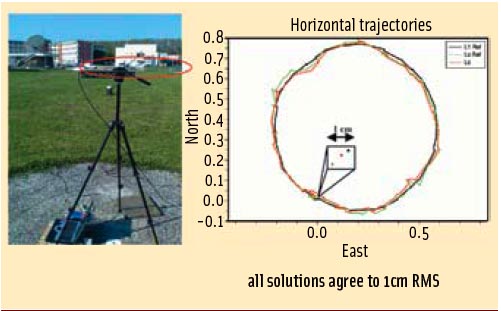Network Real Time Kinematic GPS

Q: What is the effect of user and CORS height on NRTK performance?

Q: What is the effect of user and CORS height on NRTK performance?

Working Papers explore the technical and scientific themes that underpin GNSS programs and applications. This regular column is coordinated by Prof. Dr.-Ing. Günter Hein, head of Europe’s Galileo Operations and Evolution.
By Inside GNSSTwo companies angling to provide the government with cutting-edge, GPS-based weather data may get a boost this fall if a bill aiming to improve forecasting wins U.S. House approval.
The companies, Bethesda, Md.-based Planet IQ and GeoOptics, Inc., of Pasadena, California, hope to use GPS radio occultation or GPS-OR to provide the National Oceanic and Atmospheric Administration (NOAA) and the Department of Defense with weather data.
By Inside GNSS From left, François Peyret, Valerie Renaudin, Miguel Ortiz, David Bétaille
From left, François Peyret, Valerie Renaudin, Miguel Ortiz, David BétaillePART I: Using a Reference Vehicle for Solving GNSS Localization Challenges
By Inside GNSSIn a part of the world where frustrated drivers will park anywhere, including squarely on a sidewalk, a local newspaper is using location data to shame car owners into shaping up.
The Village, a Russian online publication serving Moscow, St. Petersburg and Kiev; created a free app that notes a badly parked vehicle’s make, color, and license plate information when users snap its picture.
By Dee Ann Divis NovAtel OEM638
NovAtel OEM638NovAtel Inc. has announced the addition of the two receivers and two antennas to its GNSS product lines: the OEM638 GNSS receiver card, ProPak6 enclosure, SMART6 integrated antenna, and AG-STAR antenna.
By Inside GNSS
Doctoral-level graduate students and early-career engineers, researchers and instructors from Japan and the rest of the world will meet at a weeklong summer seminar this August in Tokyo, sponsored by the Institute of Positioning, Navigation and Timing of Japan.
The summer school will take place in from August 19 through August 24 at the Tokyo University of Marine Science and Technology (TUMSAT). Classes wil be held in English.

Trimble has introduced its next-generation unmanned aircraft system (UAS) — the UX5 aerial imaging rover with the Trimble Access aerial imaging application.
According to the Sunnyvale, California– based company, the new UAS enhances the image quality and workflows its predecessor, the Trimble Gatewing X100. Combined with the Trimble Business Center photogrammetry office software module, the Trimble UX5 is provides a UAS photogrammetric mapping solution specifically designed for surveyors and geospatial professionals.
 Prof. Jingnan Liu, Chinese Academy of Engineering
Prof. Jingnan Liu, Chinese Academy of EngineeringSince announcing plans in late 2006 to build its own GNSS system — BeiDou-2 (BDS), China proceeded quickly to establish a fully operational regional system late last year with a clear plan to complete a global system by 2020.
Beginning with its first launch in April 2007, BDS has put 16 satellites in orbit, some in dual launches, with 14 BeiDou space vehicles currently transmitting healthy signals: 5 in geostationary orbits (GEO), 5 in inclined geosynchronous orbits (IGSO), and 4 middle Earth orbit (MEO) spacecraft.
By Inside GNSS FIGURE 1: ISTA (left) and GATE (right) measuring vans at the parking place at the GATE site in Berchtesgaden
FIGURE 1: ISTA (left) and GATE (right) measuring vans at the parking place at the GATE site in BerchtesgadenWorking Papers explore the technical and scientific themes that underpin GNSS programs and applications. This regular column is coordinated by Prof. Dr.-Ing. Günter Hein, head of Europe’s Galileo Operations and Evolution.
For the complete story, including figures, graphs, and images, please download the PDF of the article, above.
By Inside GNSS Paul Flament, Head, European Commission Satellite Navigation Unit. Photo by Peter Gutierrez
Paul Flament, Head, European Commission Satellite Navigation Unit. Photo by Peter GutierrezPaul Flament is head of the European Commission’s Satellite Navigation Unit. His primary job, essentially, is to manage the Galileo program of the European Union (EU). With four operational satellites now in orbit and an ambitious schedule to set in place a constellation of 26 by 2015, Flament sat down with Inside GNSS to talk about a number of pressing issues that could affect the future of Galileo.
Flament first addressed the EU GNSS Regulation, the much-anticipated document that sets out just who will do what in the future Galileo program.
By Inside GNSS
Doctoral-level graduate students and early-career engineers, researchers and instructors from Japan and the rest of the world are invited to a weeklong summer seminar this August in Tokyo, sponsored by the Institute of Positioning, Navigation and Timing of Japan.
The summer school will take place in from August 19 through August 24 at the Tokyo University of Marine Science and Technology (TUMSAT). Classes wil be held in English.
By Inside GNSS
Topcon Positioning Systems (TPS) has announced the MR-1 Heading System, an OEM GNSS solution for high-performance positioning and heading applications on moving platforms.
Using the MR-1 receiver and Topcon’s patented MG-A8 antenna, the system provides “centimeter-accurate RTK positioning and better than 1/10 of a degree heading accuracy in challenging environments,” said Doug Langen, TPS GNSS product manager.
By Inside GNSS